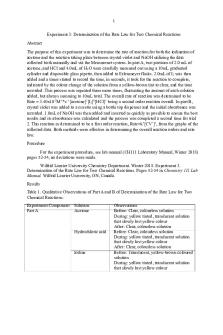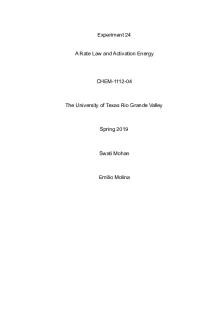Experiment 24- A Rate Law and Activation Energy PDF

| Title | Experiment 24- A Rate Law and Activation Energy |
|---|---|
| Author | David Habib |
| Course | General Chemistry II/Lab |
| Institution | Nova Southeastern University |
| Pages | 7 |
| File Size | 549.9 KB |
| File Type | |
| Total Downloads | 50 |
| Total Views | 144 |
Summary
Download Experiment 24- A Rate Law and Activation Energy PDF
Description
David Habib D05 Monday September 28, 2020
Experiment 24: A Rate Law and Activation Energy
Objective To determine the rate law of a reaction through experimentation and analyzation of results.
Hypothesis If the procedure is performed correctly, the rate law of the reaction will be able to be determined with a certain extent of accuracy through analyzation of results and graphs.
Data & Results
Graph 1:
Graph 2:
Table 2: Determination of the Reaction Order, p and q, for Each Reactant
Value of p from graph Value of q from graph
0.1564 0.5225
Kinetic Trial Value of k' Average value of k' Standard deviation of k' Relative standard deviation of k' (%RSD)
Table 3: Determination of k , the Specific Rate Constant for the Reaction 1 2 3 4 9.57E-07 1.8303E-06 2.22E-06 4.00E-06 1.55E-06 1.16E-06 75.28%
Calculations Moles of S2O320.02M = x/0.001L = 0.00002mol ∆(mol I3 –) produced Moles of S2O32-/2 = 0.00002/2 = 0.00001mol ∆(mol I3 – )/∆t (mol/s) 0.00001mol/113= 8.85E-08 log ∆(mol I3 – )/∆t log[8.85E-08]= -7.05 [I–]0 (mol/L) (0.3M*Volume KI)/10= (0.3*1)/10=.03 log [I– ]0 log[.03]=-1.52 [H2O2]0 (mol/L) (0.1M*Volume H2O2)/10= (0.1*3)/10=.03 log [H2O2]0 log[.03]=-1.52 Value of k´ ∆(mol I3 – )/∆t =k´ [I–]^0.1564 [H2O2]^ 0.5225 k´=(8.85E-08)/(0.58)( 0.16) k´=9.57E-07 Average value of k´ (9.57E-07+...+2.41E-07)/8= 1.55E-06 Standard deviation of k´ sqrt(9.57E-07+...+2.41E-07)/8= 1.16E-06
5 1.20E-06
6 1.19E-06
7 7.38E-07
8 2.41E-07
Relative standard deviation of k´ (%RSD) stdev/avg*100=1.16E-06/1.55E-06*100= 75.28%
Discussion The purpose of this experiment was to calculate the rate law of a chemical reaction through obtaining experimental results. The results were then used in graphs in order to determine the orders of the reactants and the activation energy of the reaction. The experiment began with having measured volumes of several solutions prepared at room temperature. The solutions contained reactants that were then mixed ir order to produce a color change in the solution. Once the color change was achieved, the time it took was recorded and repeated for the other seven trials. The smallest change in time was observed in trial 4 while the largest change in time was in trial 7. The value of k’ was calculated by dividing the change in moles of I3- over time by the concentrations of I- and H2O2 raised to the powers of p and q, respectively. The average and standard deviation of k’ were 1.55E-06 and 1.16E-06. When analyzing the data, it was pointed out that there was an outlier in the second graph (see Graph 2). This outlier occurred in trial 8 and the reasoning behind this is due to the volume and concentrations being chosen by the experimenter. After recording and analyzing the results from the experiment, it was shown that the results were fairly accurate. The hypothesis, in this case, is accepted for the results and analyzation of the experiment were able to determine the rate law of the reaction although the results in trial 8 were found to be outliers. As well as the hypothesis, the objective of this experiment was successfully executed.
Conclusion The purpose of this experiment was to analyze and determine a reaction’s rate law through experimentation. It was hypothesized that if performed correctly, the rate law could be successfully determined. The standard deviation and relative standard deviation of k’ were 1.16E-06 and 75.28%, respectively. From this information, it was concluded that the results were fairly accurate.
Reference(s) Beran, J. A. Laboratory Manual for Principles of General Chemistry; 10th ed.; Wiley:Hoboken, 2014.
Pre-Lab Questions...
Similar Free PDFs

Experiment 24-Rate Law
- 11 Pages

Experiment 3, Rate Law Determination
- 14 Pages

Activation Energy - Lab Report
- 6 Pages

EXP 24 - Experiment 24
- 9 Pages

Experiment 24
- 11 Pages

Experiment 24 (chemistry 2)
- 6 Pages

Rate Law Worksheet Answers
- 2 Pages

2019 MLL426 Mining and Energy Law SG
- 24 Pages

Rate Law Lab Report #3
- 4 Pages

Exp. 4 Rate Law Report
- 6 Pages
Popular Institutions
- Tinajero National High School - Annex
- Politeknik Caltex Riau
- Yokohama City University
- SGT University
- University of Al-Qadisiyah
- Divine Word College of Vigan
- Techniek College Rotterdam
- Universidade de Santiago
- Universiti Teknologi MARA Cawangan Johor Kampus Pasir Gudang
- Poltekkes Kemenkes Yogyakarta
- Baguio City National High School
- Colegio san marcos
- preparatoria uno
- Centro de Bachillerato Tecnológico Industrial y de Servicios No. 107
- Dalian Maritime University
- Quang Trung Secondary School
- Colegio Tecnológico en Informática
- Corporación Regional de Educación Superior
- Grupo CEDVA
- Dar Al Uloom University
- Centro de Estudios Preuniversitarios de la Universidad Nacional de Ingeniería
- 上智大学
- Aakash International School, Nuna Majara
- San Felipe Neri Catholic School
- Kang Chiao International School - New Taipei City
- Misamis Occidental National High School
- Institución Educativa Escuela Normal Juan Ladrilleros
- Kolehiyo ng Pantukan
- Batanes State College
- Instituto Continental
- Sekolah Menengah Kejuruan Kesehatan Kaltara (Tarakan)
- Colegio de La Inmaculada Concepcion - Cebu





